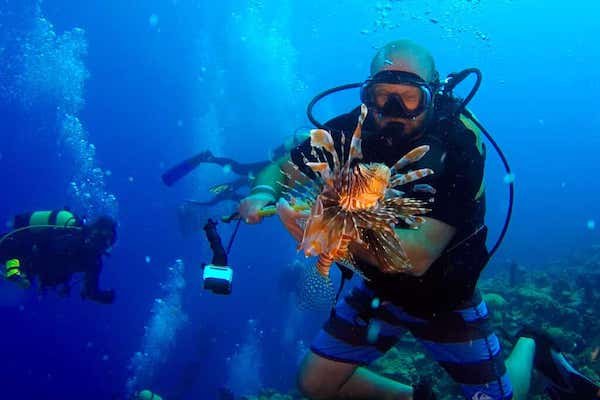Havana and Trinidad are World Heritage sites – where galleons from the past sailed into their ports.
Your diving experience is in Trinidad, a Spanish colonial city that was declared a National Heritage site by UNESCO in 1998. It is characterized by its cobbled streets, stately churches, and great architecture. There are three diving areas here: Cayo Blanco, Ensenada de Casilda, and Peninsula de Ancon. Cayo Blanco is over an hour’s boat ride from the diving center, but the other two regions are much closer.
We have included Havana, not for diving, but as one of the most charming and fascinating cities in the world. Steeped in history, Spanish colonial architecture, romantic squares and street cafes, its vibrant nightlife, the iconic and legendary Fidel Castro and Che Guevara, playground prior to the revolution during the American prohibition period with famous visitors such as Frank Sinatra, Ava Gardner, and the infamous mafia gaming casinos…
The Peninsula de Ancon is a few kilometers from the city of Trinidad. It is a narrow strip of land bordered by a sandy seabed that contains patches of coral, crests, tunnels, channels, and other features, with concentrations of coral, a wide range of sponges, sea fans (Gorgonia spp.), and tropical fish. The waters surrounding the Cuban archipelago are characterized by their smoothness – gentle tides and absence of strong currents, warmth above 24°C all year round, pristine conditions, absence of pollution and well-preserved bottoms, diversity of its underwater flora and fauna, and the total absence of aggressive animals.
The diving area has three notable underwater structures. The first is in an area where the platform is narrow with terraces defined by spider webs, where there are sandy bottoms with low coral patches and ridges that reach up to 5 meters (16 feet) high, entering the drop-off to 25-30 meters (82-98 feet) deep, where the wall begins. The second is located in an area where the platform descends by steps, and the third is located near Cayo Blanco, characterized by a bottom of large ridges and wide channels that in some places close at the top forming true tunnels. The sessile fauna is very typical, with large sponges of really varied colors and shapes, more than 40 species of corals, including walls with true forests of valuable black coral (Antipathes Salix). Deep waters, gorgonians with branches and feathers, and sea fans give a special attraction to each diving session.
Havana (Northwest Coast) The capital of Cuba since 1607, Havana (La Habana) is one of the largest and most vibrant cities in the Caribbean, and one of the most charming and fascinating cities in the world. With a population of over two million inhabitants, it has gone through great upheavals since its foundation in 1519, with revolutions and uprisings that have led to a large number of its beautiful buildings deteriorating over the years. Now many of these buildings are being restored and the city is alive with music, dance, and good museums. Old Havana, the historic center of the city, preserves a great wealth of Spanish colonial architecture and has become a UNESCO World Heritage Site.
American novelist Ernest Hemingway, who lived there for the last 22 years of his life, said that in terms of beauty, only Venice and Paris surpassed the charm of Havana. During the prohibition era of the 1920s, Havana became a very popular vacation center for Americans with nightclubs and unrestrained gambling until 1959 and the revolution.
Tourism officials like to say that Trinidad is a museum in itself. Visitors to the 500-year-old city will find Spanish colonial architecture, highlighting the colonial ambiance that marks the small town as one of the country’s top attractions. With just a few square blocks, historic Trinidad is famous for its charming cobblestone streets, pastel-colored homes with elaborate wrought-iron grilles, as well as its majestic palaces and plazas. The city can be toured in a few hours, either on foot or by horse-drawn carriage.
The city is located near the Escambray Mountains and the Caribbean beach. One of the area’s attractions is the Valley of the Sugar Mills, which has been declared a UNESCO World Heritage Site. The valley has around 70 old sugar mills that are a reminder of the importance of sugar in the Cuban economy throughout the centuries. It has the Iznaga Tower, a 45-meter tower built by Alejo Iznaga Borrell in 1816. 20 km from the city is Topes de Collantes, one of Cuba’s main ecotourism centers.
Another attraction is the Bay of Casilda, which attracts both divers and snorkelers. A nearby islet has pristine beaches. Playa Ancón is a white sand beach that has several 3/4-star beach hotels. Ancón was one of the first new tourist centers developed in Cuba after the 1959 revolution. Along the Ancón Peninsula, there are three hotels: Hotel Costa Sur, Hotel Ancón, and Brisas Trinidad del Mar (opened in 2002). The newest hotel in the city center, the Iberostar Trinidad Grand, has a 5* rating.








